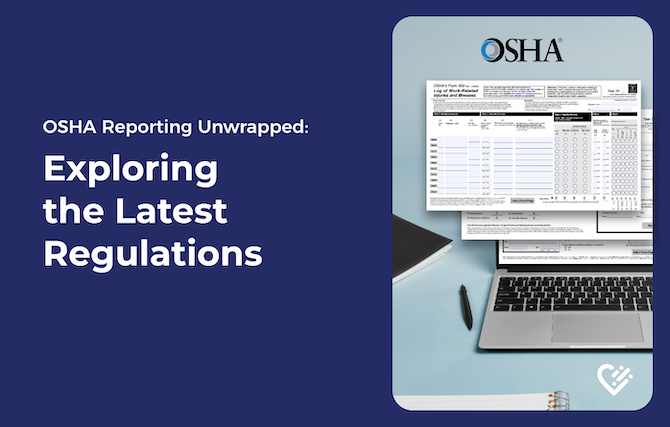Changes are here. Important ones.
The Occupational Safety and Health Administration (OSHA) recently rolled out some new regulations. But what are they? What do they mean? And who will they affect?
Here’s what you need to know today.
The new OSHA rules
As of January 1, 2024, designated employers with over 100 employees are now required to electronically submit forms 300, 300A, and 301 about their workplace injuries and illnesses to the OSHA annually. This new final rule amends the original workplace injury and illness record-keeping regulations (29 CFR Part 1904).
Moving forward, designated employers will be required to electronically submit three forms:
- Form 300A Summary of Work-Related Injuries and Illnesses summarizes and reports workplace injuries and illnesses during the previous calendar year. It provides a snapshot of the organization’s safety record and is required by OSHA for most organizations with over ten employees. The form aggregates data from Form 300 and Form 301, summarizing the total number of cases and other relevant details.
- Form 300 Log of Work-Related Injuries and Illnesses contains a detailed record that employers must maintain under OSHA regulations. This form documents specific information about each workplace injury or illness. Form 300 is a comprehensive log that provides a thorough record of injuries and illnesses, enabling employers to track trends, identify hazards, and take appropriate measures to improve workplace safety.
- Form 301 Injury and Illness Incident Reports, which OSHA requires to provide additional details about work-related injuries and illnesses beyond what is captured on the OSHA Form 300 Log. The Form 301 may include information about the affected employee, the incident’s circumstances, and medical treatment provided. This form helps employers and OSHA gather comprehensive data to identify workplace hazards and improve health and safety measures.
The submission process also involves providing detailed injury and illness information, including the legal company name, through OSHA’s Injury Tracking Application (ITA).
This data not only helps OSHA monitor workplace safety but also serves as a valuable resource for employers, employees, researchers, and the general public to make informed decisions regarding workplace health and safety practices.
Simply put, it’s time to roll up those sleeves because you’ll need to provide all three detailed injury and illness forms for the entire calendar year of 2023 by March 2, 2024.
Getting started
It sounds stressful. We know. But it doesn’t have to be.
Here’s a quick checklist to help you navigate through this maze of regulations:
1. First things first, figure out if these new rules apply to you. Are you in one of the designated industries with over 100 employees? Learn more here.
2. Double-check your record-keeping procedures. Make sure you’re dotting your I’s and crossing your T’s when it comes to filling out OSHA Forms 300, 301, and 300A.
3. Start gathering and organizing all those forms from the 2023 calendar year. You don’t want to be scrambling at the last minute!
4. If you still need to, set up an Injury Tracking Application (ITA) account and a gov account.
5. Establish your submission method for Forms 300, 301, and 300A. Options include manual data entry, uploading a CSV file to include multiple establishments simultaneously, or transmitting data electronically through an API (application programming interface).
6. Nail down the “who.” Ensure they become familiar with the ITA account prior to form submission.
7. Last but not least, make a game plan to ensure all forms are submitted before the deadline hits. Trust us, you don’t want to be dealing with any last-minute technical glitches!
The wrap-up on 2024 OSHA rules and latest regulations
As OSHA continues to prioritize workplace safety through enhanced reporting requirements, it’s essential for employers to stay abreast of these changes.
Understanding and adhering to OSHA reporting regulations is vital for ensuring workplace safety and compliance. With Immuware’s incident management solutions, healthcare organizations can navigate these requirements with ease, ultimately fostering safer work environments and promoting employee well-being.
Get started exploring our capabilities here.

